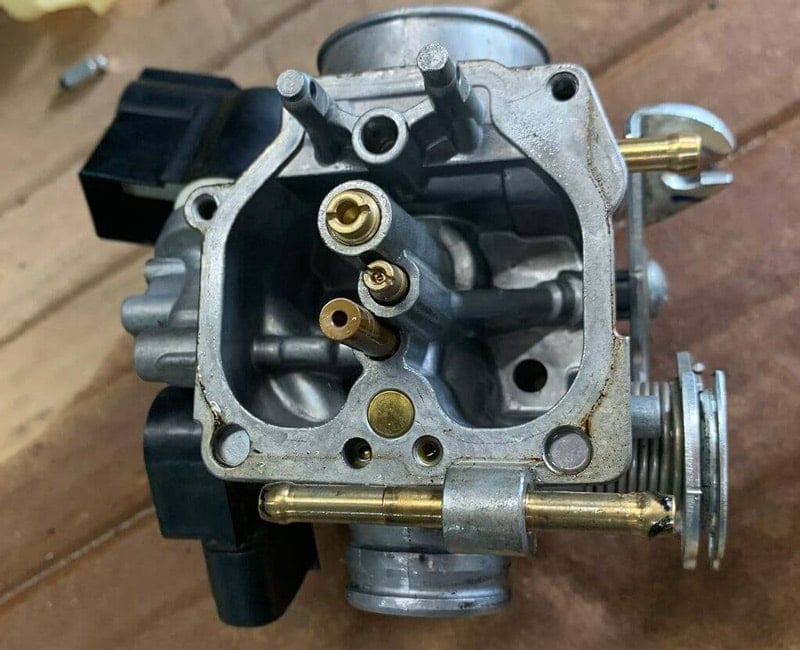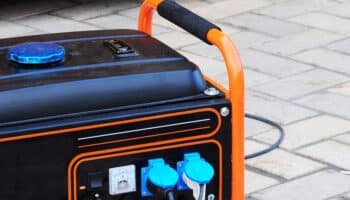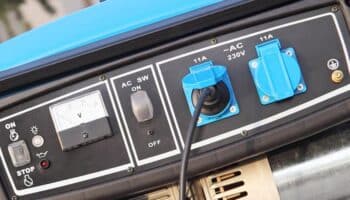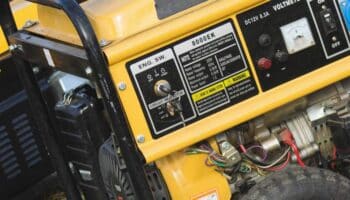The storm has knocked out your neighborhood’s power, but you’re not worried. You thought ahead and got a generator. You’re feeling pretty smug – right up until the lights flicker off again in the middle of Family Board Game Night. You fire the machine back up, but the same thing happens again. Why is your generator constantly cutting out? And how can you make it stop?
If you haven’t used the generator in a while, you might just be forgetting a step. The machine may be low on oil or gas. You might be leaving the fuel valve or the clutch closed. Or it could be something more serious, like a damaged power cord or spark plug.
We don’t want to leave you in the dark. That’s why we’ve put together this list of 9 typical generator problems. If you want to find and fix what’s cutting off your generator, then dive in and start reading!
Why Is My Generator Cutting Out?
#1: Low Fuel
We’ll start with an easy one. If your generator doesn’t have enough gas to run, well, it won’t. Sometimes the machine can start up even if the tank is almost empty, but it will soon cut out. This isn’t a problem if your generator hooks into your home’s fuel line. But smaller portable models need you to refill them.
It’s embarrassing to realize you forgot to check the fuel level before startup, but hey, better late than never.
Even if the gauge says there’s plenty of gas left, you could still have a fuel issue. Have you left your generator powered down for months? When gas sits in the machine for a long time, it starts to degrade.
Try draining the gas tank and the float bowl of your carburetor. Refill it and see if your device can run steadily this time.
In the future, you should drain your generator before putting it into storage. It’s like cleaning out your fridge so stuff doesn’t go bad in there. Siphon it into your gas can and then run the generator until you’ve used up whatever you couldn’t drain.
#2: Closed Fuel Valve
Getting fuel in the tank is only half the battle. It also needs to be able to get from the tank to the engine.
Fuel issues can also cause your generator to backfire.
We do recommend closing the fuel shutoff valve when you power down your generator – but remember to flip it back on before starting up again. Otherwise, your unit will only run until it’s burned through any leftover gas from last time.
The shutoff valve is a small switch, usually with a flat metal tab. You can find it on the hose that runs into the carburetor, near the air filter assembly. Make sure it’s switched to the “open” position. This may be all it takes to solve your problem!
While you’re back there, you should also take a look at the fuel tank and pipes. If you see gas on the lines or pooling underneath the unit your generator could be leaking. This calls for immediate repair or replacement of the faulty parts.
If you want to get any replacement part – or see how much one would cost – click to enter your model number in the search bar below. Our partners at AppliancePartsPros stock almost every part with free guides on how to install them.


#3: Low Oil
Along with fuel to power it, a generator needs oil to work. The oil keeps the engine from overheating or breaking due to friction. If there’s too little oil, your generator may backfire. Or it might run for a few minutes before the low oil sensor shuts it down. This is irritating, but it’s better than risking permanent damage to the motor.
Check the oil level. Most generators have a dipstick like the one in your car. Pull it out, wipe it off with a rag, then pop it back in. After about 30 seconds, take it out and check whether the oil is above the “empty” mark. If not, go ahead and refill it.
Like gasoline, oil can go bad over time. It should be a yellow-orange color and mostly clear. If it’s dark, sludgy, or filled with grit, it’s no good. Empty the oil tank and put fresh stuff in.
#4: The Choke Is Still On
A generator needs a mix of fuel and air to operate. When it’s first starting up, that blend has to be heavier on the fuel. That’s why your machine has a choke lever, usually sitting above the air filter housing. You have to close this to turn the engine on, but open it up after the generator warms up.
If you forget that second step, your unit will start to strangle until it cuts off after a few minutes. Make sure to flip the switch to half choke after a few minutes. Then open it all the way after a few minutes more. Your generator should run smoothly after that.
#5: Frayed Power Cords
Take a look at the cord running power from your machine. Sometimes these wires can wear down without completely breaking. In a way, this is more dangerous, because the generator might start up but then overheat. It could also spark a fire or give you an electric shock.
If the cord is fraying and losing its insulation, unplug it carefully and start looking for a replacement.
Fun fact: One common reason for messed-up wires is that mice like to nestle in the warmth of your generator. They tend to chew through anything around them, whether it’s food or just rubber and wire. If you find a worn cord, you may want to consider setting a few traps.
#6: Overloading
Even a beefy generator can’t always handle the same power load as your local grid. When you try to run too many devices and appliances at once, your unit may shut down in self-preservation. Older generators often lack this auto-shutoff feature. That can cause bigger problems in the long run, though.
Check to see if your generator has an overload indicator light. If this little diode is giving you a red glare, it means you’ve asked it to do too much. And your device’s manual can tell you what its maximum capacity is. Your generator may also sound louder and rougher than usual when it’s near the limit.
If you don’t know how to calculate or estimate your total power load, you can take a trial-and-error approach. Switch off most of your lights and unplug all but the essential appliances. Then try your generator again. If it works without shutting down, you’ve cracked the case.
#7: Bad Spark Plugs
Is your generator only running for a few seconds before shutting off? Are you hearing a crackling noise before it cuts out? These can be signs of a failing spark plug. If this component isn’t working, your generator can’t ignite the fuel that lets it run.
You might be able to fix it by cleaning it off. Power off your generator and shut the fuel valve before starting! Then slide off the rubber “boot” or cap over the spark plug. This should be above the valve cover on the generator’s engine. Unscrew the plug. Your machine probably came with a specialized wrench for this purpose.
Now look for signs of damage or built-up gunk. Throw out your spark plug and replace it if you see any of the following signs:
- Cracked or flattened electrodes
- Melted areas
- Rusted or pitted spots
- Whitish buildup
- Bubbles in the metal on the tip
If it looks dark and grimy but otherwise intact, your spark plug may just be dirty. Spray it down with some carburetor cleaner and scrub away the sludge and oil with a wire brush. Wipe it down with a clean rag and let it air-dry for a bit. Then put it back in your generator and see if you can start it up.
#8: Dirty Air Filter
If you’ve read this far, you know that your generator needs airflow to run. It also needs to avoid sucking in something that will clog its windpipe. The air filter blocks grit and debris while letting your machine take in air.
Over time, this filter gets pretty filthy. Once it’s picked up enough schmutz, not enough air can get through to keep your generator running. You might be able to get it working again with a quick cleaning.
Before getting started, turn off the power, shut the fuel valve, and take the boot off the spark plug. You don’t want any chance of your generator trying to start up while you work.
The air filter is usually inside a rectangular compartment made of plastic or metal. Detach the clips or screws holding the cover in place and take it off. The filter itself is a soft block of foam. Pop it out and clean it with dish soap or laundry detergent and warm water. Squeeze it dry with a cloth, but don’t twist.
Next, apply a thin coating of engine oil to one side of your filter and let it soak in a bit. Mop up the excess oil with a rag or cloth. Put the filter back into the housing, with the oiled side facing in. Replace the covering and clip or screw it back in.
If the filter is torn, brittle, or falling apart, you’ll have to replace it. As a rule, you should swap your filter out after every 100 hours you run the generator.
#9: Dirty Carburetor

Another part that can clog from the steady buildup of grime is the carburetor. This can cause a backfire or shut your generator down after just a few seconds.
Cleaning your carburetor is a little tricky, but you should be able to handle it with a little preparation and patience. Start by grabbing:
- some carburetor spray cleaner
- a thin piece of wire
- a small brush
- a cotton swab
- a set of pliers
- some clamps
- screwdrivers – both Phillips and flathead
- a bucket
- a few clean rags
Shut everything down on your generator. That includes the power, the fuel valve, and the spark plug. Then take off the air filter assembly. Clamp the fuel line and detach the carburetor. You’ll need to unhook the wire spring and metal rod that attach to the throttle. Pliers are helpful here.
Once the carburetor is off, you can spray down the outside with carburetor cleaner. Then take it apart slowly. Take the time to lay out each piece on a cloth, so you don’t lose track of anything. Clean every surface with your spray, your brush, and your swab. Use the wire and some bursts of air from the spray bottle to clean out even the tiniest openings.
Before you put the carburetor back together, wash your hands. You don’t want to put back any of the sludge you just cleaned off! Reassemble the carburetor, inspect it, and replace any damaged gaskets you noticed during disassembly.
What If Your Generator Still Cuts Out?
If you’ve tried all the options above but you’re still losing power, there are a few possible problems remaining:
- Exhaust troubles
- Faulty wiring
- Engine problems
- Sensor malfunction
- Block heater failure
Issues like these are a bit beyond what we’d advise a handy homeowner to tackle on their own. Unless you have some expertise in electrical and engine repair, now’s the time to call a professional.
Conclusion
The first thing to do when your generator won’t stay running is to run through your startup checklist again. Check the fuel, the oil, and the choke. Inspect the power cord for damage, and check whether you’ve overloaded your machine. If you still haven’t found the reason your generator is cutting out, check for more advanced issues like bad spark plugs or air filters.
We hope that your generator is now running like a champ once again. And we’re flattered that you came to us for advice! If you liked this article and want to learn more, take a look at the related posts below.









